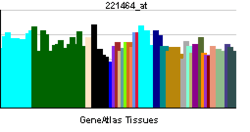OR1D2
| View/Edit Human | View/Edit Mouse |
Olfactory receptor 1D2 is a protein that in humans is encoded by the OR1D2 gene.[3][4][5]
Olfactory receptors interact with odorant molecules in the nose, to initiate a neuronal response that triggers the perception of a smell. The olfactory receptor proteins are members of a large family of G-protein-coupled receptors (GPCR) arising from single coding-exon genes. Olfactory receptors share a 7-transmembrane domain structure with many neurotransmitter and hormone receptors and are responsible for the recognition and G protein-mediated transduction of odorant signals. The olfactory receptor gene family is the largest in the genome. The nomenclature assigned to the olfactory receptor genes and proteins for this organism is independent of other organisms.[5]
See also
References
- ↑ "Human PubMed Reference:".
- ↑ "Mouse PubMed Reference:".
- ↑ Parmentier M, Libert F, Schurmans S, Schiffmann S, Lefort A, Eggerickx D, Ledent C, Mollereau C, Gerard C, Perret J, et al. (Mar 1992). "Expression of members of the putative olfactory receptor gene family in mammalian germ cells". Nature. 355 (6359): 453–5. doi:10.1038/355453a0. PMID 1370859.
- ↑ Buck L, Axel R (May 1991). "A novel multigene family may encode odorant receptors: a molecular basis for odor recognition". Cell. 65 (1): 175–87. doi:10.1016/0092-8674(91)90418-X. PMID 1840504.
- 1 2 "Entrez Gene: OR1D2 olfactory receptor, family 1, subfamily D, member 2".
Further reading
- Selbie LA, Townsend-Nicholson A, Iismaa TP, Shine J (1992). "Novel G protein-coupled receptors: a gene family of putative human olfactory receptor sequences.". Brain Res. Mol. Brain Res. 13 (1–2): 159–63. doi:10.1016/0169-328X(92)90057-I. PMID 1315913.
- Ben-Arie N, Lancet D, Taylor C, et al. (1994). "Olfactory receptor gene cluster on human chromosome 17: possible duplication of an ancestral receptor repertoire". Hum. Mol. Genet. 3 (2): 229–35. doi:10.1093/hmg/3.2.229. PMID 8004088.
- Schurmans S, Muscatelli F, Miot F, et al. (1993). "The OLFR1 gene encoding the HGMP07E putative olfactory receptor maps to the 17p13→p12 region of the human genome and reveals an MspI restriction fragment length polymorphism". Cytogenet. Cell Genet. 63 (3): 200–4. doi:10.1159/000133534. PMID 8097991.
- Nekrasova E, Sosinskaya A, Natochin M, et al. (1996). "Overexpression, solubilization and purification of rat and human olfactory receptors". Eur. J. Biochem. 238 (1): 28–37. doi:10.1111/j.1432-1033.1996.0028q.x. PMID 8665947.
- Glusman G, Sosinsky A, Ben-Asher E, et al. (2000). "Sequence, structure, and evolution of a complete human olfactory receptor gene cluster". Genomics. 63 (2): 227–45. doi:10.1006/geno.1999.6030. PMID 10673334.
- Fuchs T, Malecova B, Linhart C, et al. (2003). "DEFOG: a practical scheme for deciphering families of genes". Genomics. 80 (3): 295–302. doi:10.1006/geno.2002.6830. PMID 12213199.
- Strausberg RL, Feingold EA, Grouse LH, et al. (2003). "Generation and initial analysis of more than 15,000 full-length human and mouse cDNA sequences". Proc. Natl. Acad. Sci. U.S.A. 99 (26): 16899–903. doi:10.1073/pnas.242603899. PMC 139241
 . PMID 12477932.
. PMID 12477932. - Spehr M, Gisselmann G, Poplawski A, et al. (2003). "Identification of a testicular odorant receptor mediating human sperm chemotaxis". Science. 299 (5615): 2054–8. doi:10.1126/science.1080376. PMID 12663925.
- Malnic B, Godfrey PA, Buck LB (2004). "The human olfactory receptor gene family". Proc. Natl. Acad. Sci. U.S.A. 101 (8): 2584–9. doi:10.1073/pnas.0307882100. PMC 356993
 . PMID 14983052.
. PMID 14983052. - Gerhard DS, Wagner L, Feingold EA, et al. (2004). "The status, quality, and expansion of the NIH full-length cDNA project: the Mammalian Gene Collection (MGC)". Genome Res. 14 (10B): 2121–7. doi:10.1101/gr.2596504. PMC 528928
 . PMID 15489334.
. PMID 15489334.
External links
- OR1D2 protein, human at the US National Library of Medicine Medical Subject Headings (MeSH)
This article incorporates text from the United States National Library of Medicine, which is in the public domain.

